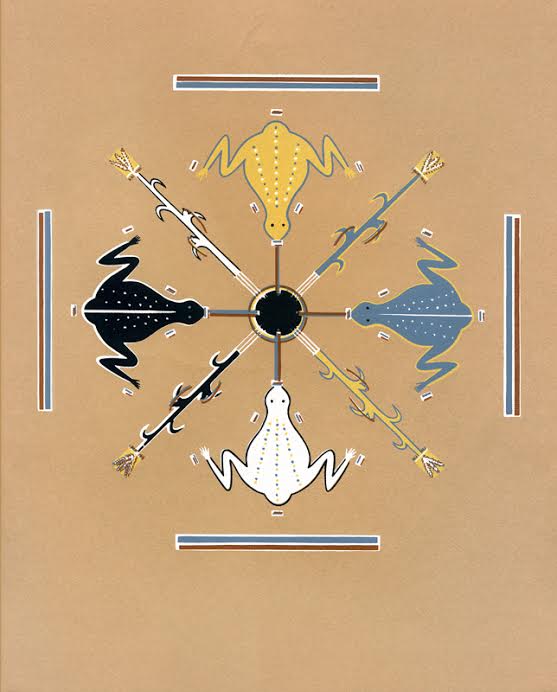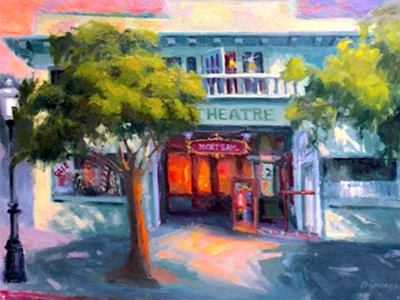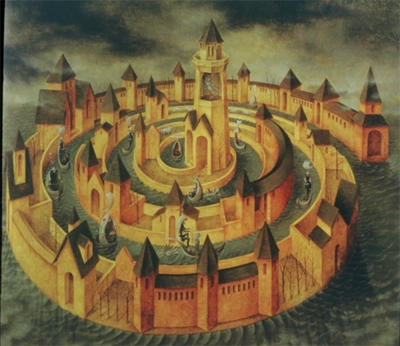ARAS Connections: Image and Archetype - 2022 Issue 1

Journeys of the Imagination
In this edition of ARAS Connections we feature articles about three extraordinary artists: Millie Kutz, Steven Coleman, and Remedios Varo. The articles are linked by at least two primary themes:
1. Each of the articles focuses on journeys of the imagination, sometimes as a way to escape reality, sometimes as a source of healing and spiritual development and sometimes as both. In each, the imaginal journey comes as a response to tremendous stress, both inner and outer. In all three, the artists are seeking a life-line and a source of renewal through the imagination. In the first two, the COVID pandemic stopped outer life in its tracks—of Millie Kutz as a senior in high school and of Steve Coleman as the set designer of his beloved Throckmorton Theatre. In the third paper, cultural restrictions and The Spanish Civil War and World War 2 created enormously difficult circumstances for Remedios Varo.
2. Secondly, one can see a developmental movement from one article to the next, each imaginal journey coming in the service of the needs of an individual in various stages of the life cycle and, in one case, in the life of an organization.
An imaginal journey in youth
Millie Kutz is a young artist of enormous talent and vision. She created her imaginal journey during COVID and later reflected on the process in interviews with Jean Kirsch and Tom Singer. Her imagination served as a lifeline and commentary on her relationship to technology in a time of isolation and overwhelming stress.
An imaginal journey in mid-life of an individual and an organization
Steve Coleman is a set designer and artist in mid-life who harnessed his extraordinary skills of craftsmanship and vision to provide a lifeline for his Mill Valley, California Throckmorton Theatre that had been stopped dead in its tracks by COVID. He shared his journey with Tom Singer who participated in the creative act by bringing his own imaginal world to the process.
An imaginal journey in older age
Finally, we follow Remedios Varo’s journey of individuation as an older artist facing the final stages of life. Her journey is beautifully portrayed through the seasoned eyes of Mary Wells Barron who has elucidated the unfolding symbolic iconography of Varo’s extraordinary imaginal journal.
Welcome to this edition’s multifaceted journeys of the imagination.
Mille's COVID Fever Dreamscapes

Introduction
We all have had some awareness of how difficult it has been for younger school age people and their parents during COVID. But, now we are incredibly fortunate to get a look at what this stressful time has been like through the eyes of Millie Kutz, a young artist who is both visually articulate and finely tuned in her sensibilities. Like all her peers, Millie was only able to attend school virtually for most of her senior year of high school. Social contact outside the home was severely limited and interaction with peers and the world was conducted almost exclusively via the internet. In the midst of this prolonged, enforced time at home, Millie experienced a three-month creative burst from March 31 to July 9, 2021, during which time she produced an extraordinary series of over eighty vivid images that give expression to the altered inner and outer world in which she found herself during the collective COVID quarantine from school. This article features twenty of these images that Millie calls Dreamscapes since some of them appeared to her in dreams.
These are not just the images of a most talented young woman but an extraordinary glimpse into what many young people might have experienced during the pandemic. The combination of social isolation and increasing dependency on the internet and its burgeoning social media poses a great danger for young people who are increasingly vulnerable to the seductions of an alternate virtual reality. Millie is giving us a picture not only of her own psyche but an artistic vision of what is already present in her generation and on the horizon for the collective psyche of future generations. Millie’s drawings were done in a kind of personal and collective metaphoric fever induced by COVID 19. Whether or not we actually had COVID, the whole world was caught in this fever.
We begin the tour of Millie’s work with an overview of the context in which she found herself immersed during this creative outpouring. As with the tour of the images themselves we rely on Millie’s own words to describe her process in two interviews with Jean Kirsch and Tom Singer.
Read Millie’s COVID Fever Dreamscapes in its entirety here.
A Portal to the Imaginal: Steve Coleman, the Mill Valley Throckmorton Theatre, and Ingmar Bergman’s Fanny and Alexander

Everything can happen
Everything is possible and probable.
Time and Space do not exist.
On a flimsy framework of reality
The imagination spins,
Weaving new patterns.
-August Strindberg. A Dream Play.
In the small town of Mill Valley, nestled at the base of Mt. Tamalpais and just north of San Francisco, sits the Throckmorton Theatre (Figure 1). It has served as a community center for film and a variety of performing arts for over one hundred years. It first opened showing Charlie Chaplin movies in 1915 and more recently has witnessed a spirited renaissance under the direction of Lucy Mercer. It has attracted artists, musicians and performers from around the globe, offering music concerts and festivals, comedy, youth theatre productions, salons, classes and art exhibitions. Musicians including Carlos Santana, Norah Jones, Huey Lewis and Sammy Hagar; comedians like Robin Williams, Mort Sahl, and Dana Carvey; actors such as Ed Asner, Diane Wiest, and Tony Shalhoub; and community members from diverse parts of the area have all felt at home and creatively inspired on the theatre’s stage.
Steve Coleman and the COVID Moment
Among the many treasures of the Throckmorton Theatre, none has played a more important role than Steve Coleman, a resident of Mill Valley since his childhood in the mid-1950s. Steve has been the set designer and much more at the Throckmorton Theatre for twenty years. In turn, the Throckmorton Theatre has served as his studio, workshop, and playground for collaborative projects. Steve’s personality, energy, talent, and spirit are a living portal to the imaginal. He embodies a bridge between our everyday reality of twenty-first-century America and other times and places, including psychic spaces and realities. Steve does not use a cell phone; he does not use computers; he does not own a car. He carries a sketch book at all times and his imagination roams the natural world and other historic eras as he evokes a world that beckons with delight, enthrallment, and mystery.
During the era of COVID, Steve has come to play an even more special role at the Throckmorton Theatre. He would never claim to be a shaman, but he and his collaborators have taken on the responsibility of keeping the spirit of the theatre alive in the dark times of the pandemic. Steve spoke to me about the impact of the siege of COVID on the Throckmorton Theatre:
“It makes me so sad when I see the empty stage and just the columns on the sides of the proscenium. It’s like I could sense all the ghosts of all the people that ever performed in the theatre. I have seen so many performances, so many hours of being with the performers and felt the connection with the audience. And, it would make me weep because it’s all lost. I mean we’ve just been in a state of frozen disconnection.”
“A state of frozen disconnection” is a good description of what happens when a pandemic strikes and when the dark mood of a dystopian vision of the world takes possession of the collective psyche as it has in this contemporary time. Among its many casualties is the capacity to imagine a positive future. In such a mood of profound dis-ease, fear, anger, uncertainty, sadness and loss, Steve took on with an unassuming charisma the role of breathing life into a theatre on life support.
Some two months after the theatre had to shut down in March 2020, a Throckmorton leadership team consisting of Steve Coleman, Lucy Mercer, Mary Dilts and Bruce Treymane gathered for a group Tarot reading (after all, this is Mill Valley, California and the esoteric has its place and meaning). The question that the four held in their minds and hearts while consulting the Tarot concerned the future of the theatre. With the duration of the shutdown unknown, could the down time be used to imagine potential new beginnings? What were some strategies for survival during COVID? The overall theme that emerged from the reading was “the Moon” which, according to the Wild Unknown Tarot Guidebook (by Kim Krans 2012) suggested to them: “the shadow realm, where dreams, fears and mysteries are born. Many great artists have roamed this inner landscape. It’s where imagination and creativity drift freely upon the midnight air.” In the photograph next (Figure 5), Steve is accompanied at the Tarot reading by his long time alter-ego puppet companion in his tattered clothes whom he describes as “a character who has outlived his period of history and has left that world behind, only to find himself disheveled and disoriented in a contemporary world that he sees filtered through the lens of another time and world.”
Remedios Varo: Her Spiral Journey

Forward
As the year 2022 begins, I reflect on why it feels the right time to offer this work on Remedios Varo’s Spiral Journey to ARAS Connections. Perhaps it is due to the sense that, at this moment in history, our collective consciousness needs to see the immense creativity of a woman both deprived of her homeland by a Fascist regime’s victory in the Spanish Civil War and who was forced to flee her adopted country when the Nazis invaded France.
Her courage and tenacity, along with an extraordinary capacity for friendship, according to Janet Kaplan, allowed her to finally find a hospitable new home in Mexico where her creativity bloomed and her greatest works were painted. Jung said: “ Only a thing that changes and evolves lives, but static things mean spiritual death “ ( C.W. vol. 18 para 1595 ) Remedios’ life and art was one of both change and spiritual evolution. In this way it is a beacon for the times we are living through now.
The labyrinth, the spiral path is the sacred approach to the world invisible to human senses, but ever present as an image within the soul.
Like a snail’s shell, the spiral path is where we live. It is all around us – even though we cannot see it.
The spiral is associated with the moon and the rhythm and flow of the oceans’ tide. It is the rhythm and movement of folk and tribal dance and the blur of the Whirling Dervish. Dance was one of the earliest forms of worship. It invoked fertility, protection and transformation and was, therefore, essential to the shaman.
The spiral is linked too with the journey or pilgrimage. While most often we read about the masculine heroic journey, Remedios Varo’s paintings created during the last decade of her life, reveal the thresholds of the uniquely feminine path toward wholeness.
This journey is often imaged as a labyrinth or spiral.
“the treading of an obstructed path is the key motif of labyrinth symbolism. The maze being a symbol of the outer shell around the hidden center. Overcoming the obstacle that obstructs the entry into the center denotes transformation; and re-emergence from its re-birth.”
And so, we carry with us the ubiquitous historical and cultural nature of this archetypal image of the spiral, as we explore this motif in Varo’s paintings.
Read Remedios Varo: Her Spiral Journey in its entirety here.
Contents
Become a Member of ARAS!
Become a member of ARAS Online and you'll receive free, unlimited use of the entire archive of 17,000 images and 20,000 pages of commentary any time you wish—at home, in your office, or wherever you take your computer.
The entire contents of three magnificent ARAS books: An Encyclopedia of Archetypal Symbolism, The Body and The Book of Symbols are included in the archive. These books cost $330 when purchased on their own.
You can join ARAS Online instantly and search the archive immediately. If you have questions, please call (212) 697-3480 or email info@aras.org
We Value Your Ideas
As our newsletter grows to cover both the ARAS archive and the broad world of art and psyche, we're eager to have your suggestions and thoughts on how to improve it. Please send your comments to info@aras.org. We look forward to your input and will reply to every message.
Subscribe
If you're not already a subscriber and would like to receive subsequent issues of this newsletter by email at no cost, e-mail us at newsletter@aras.org.
